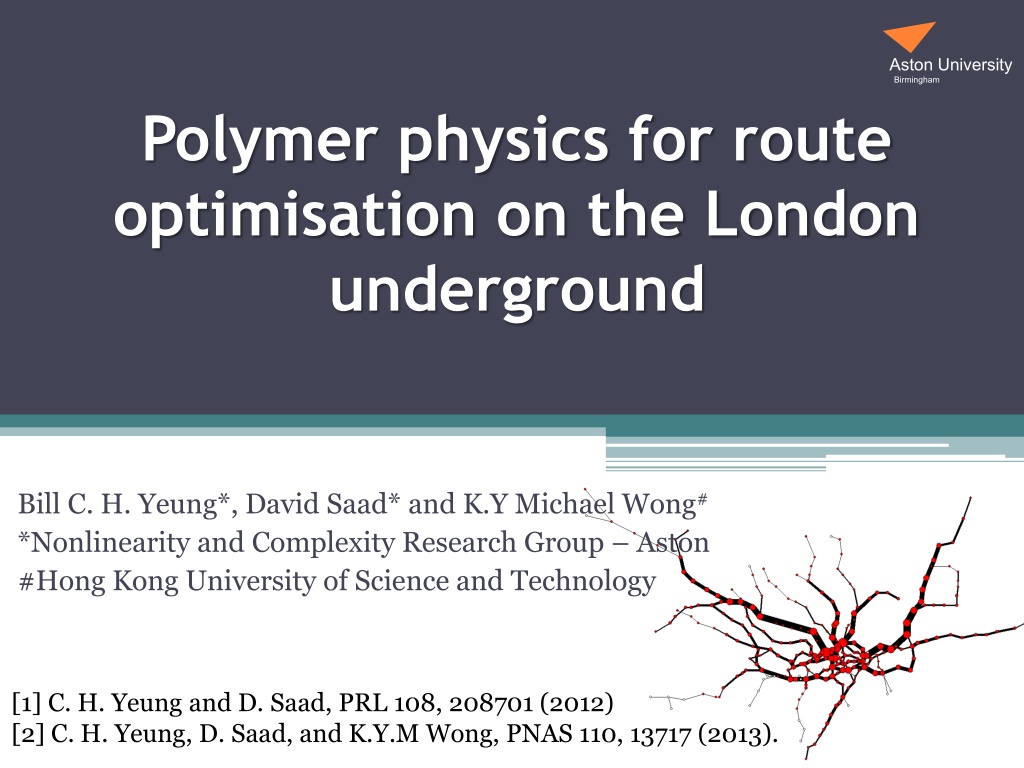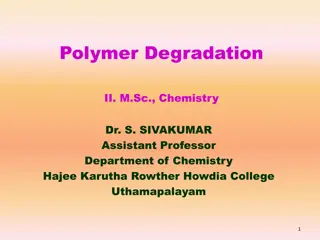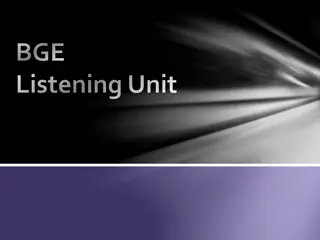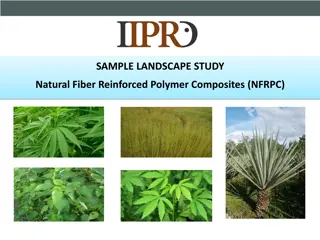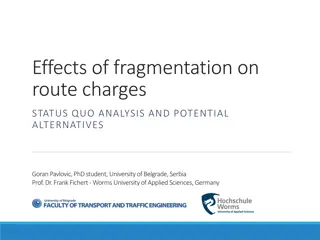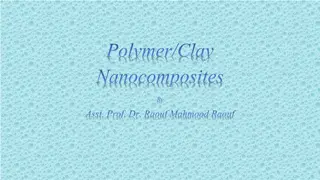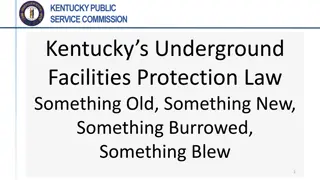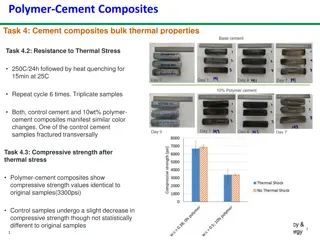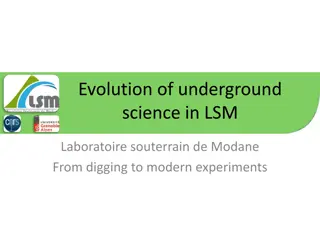Polymer Physics for Route Optimization on the London Underground
Aston University's research on polymer physics applied to route optimization on the London Underground addresses the challenges of routing algorithms, interaction among communications, and the need for choices-sensitive optimization. The study explores models to minimize congestion and optimize traffic flow in complex networks like subway and air traffic systems.
Download Presentation

Please find below an Image/Link to download the presentation.
The content on the website is provided AS IS for your information and personal use only. It may not be sold, licensed, or shared on other websites without obtaining consent from the author. Download presentation by click this link. If you encounter any issues during the download, it is possible that the publisher has removed the file from their server.
E N D
Presentation Transcript
Aston University Birmingham Polymer physics for route optimisation on the London underground Bill C. H. Yeung*, David Saad* and K.Y Michael Wong# *Nonlinearity and Complexity Research Group Aston #Hong Kong University of Science and Technology [1] C. H. Yeung and D. Saad, PRL 108, 208701 (2012) [2] C. H. Yeung, D. Saad, and K.Y.M Wong, PNAS 110, 13717 (2013).
2 Presentation outline Motivation why routing? The models two scenarios One universal source Ordinary routing Results: microscopic solution, macroscopic phenomena Applications: e.g. subway, air traffic networks Conclusions
3 Motivation
4 Why routing? Are existing algorithms any good? - Routing tables computed by shortest-path, or minimal weight on path (e.g. Internet) - Geographic routing (e.g. wireless networks) Des 1: k Des 2: j D j i Des 1 source destination k - Insensitive to other path choices congestion, or low occupancy routers/stations for sparse traffic - Heuristics- monitoring queue length sub-optimal
5 Choices-sensitive optimization, difficult? 1. A sparse network with non-local variables Unlike most combinatorial problems such as Graph coloring, Vertex cover, K-sat, etc. source destination 2. Non-local interaction among communications: avoid congestion repulsion consolidate traffic attraction communications interact with each other Interaction is absent in similar problems: spanning trees and Stenier trees [3] M.Bayati et al , PRL 101, 037208 (2008)
6 Models
7 The model N nodes (i, j, k ) M communications ( ,..) each with a fixed source and destination Denote, j = 1 (communication passes through node j) j = 0 (otherwise) Traffic on j Ij = j cost >1 =1 <1 Ij Find path configuration which globally minimizes H= j(Ij) or H= (ij)(Iij) - >1 repulsion (between com.) avoid congestion - <1 attraction aggregate traffic (to idle nodes) - =1 no interaction, H= j j shortest path routing
8 Realistic? Optimal path configuration is static fine when the source and destination have steady traffic: p2p file sharing, traffic between subway stations . Routing problems generally involve dynamics, current model is only a simplified representation To include temporal traffic in the same framework use space-time network destination k . . . i i source source destination j j k t=0 t=1 t=2 t=3
9 Two scenarios studied One universal source Ordinary routing e.g. internet, p2p networks, transportation (e.g. subway, air traffic), etc. e.g. broadcast or multicast, sensor networks, network with outlet/central router, etc. [1] C. H. Yeung, D. Saad, PRL 108, 208701 (2012) [2] C. H. Yeung, D. Saad, K.Y.M Wong, PNAS 110, 13717 (2013) Phenomena/quantities observed: path length, fraction of idle nodes, data collapse (scaling), phase transition, RS/RSB, .
10 Scenario Routing to Base Station/Central Router
11 Analytical approach Map the routing problem onto a model of resource allocation: Each node i has initial resource i - Receiver (base station, router) - Senders (e.g. com. nodes) - others i= + i= -1 i= 0 A example of ground state with =2 avoid congestion, unlike spanning/Stenier trees Minimize H= (ij)(Iij) Constraints: (i) final resource Ri= i+ j LIji= 0, all i (ii) currents are integers resource Central router com. nodes (integer current) each sender has to establish a single path to the receiver
12 The cavity method Ei(Iil) = optimized energy of the tree terminated at node i without l At zero-temperature, we use the following recursion to obtain a stable P[Ei(Iil)] L j = + ( ) min I | | ( ) E I I E I i il il j ji = {{ | } ji 0 } R i { \ i } l Algorithm: However, constrained minimization over integer domain difficult >1, we can show that Ei(Iil) is convex computation greatly simplified (ij I ) E i j (ij I ) E j i [1] Yeung and Saad, PRL 108, 208701 (2012)
13 Results - Non-monotonic L 2i.e. =2 avoid congestion H= (ij)(Iij) M number of senders ??? Small deviations between simulation - finite size effect, N , deviation Average path length per communication Random regular graph k=3 Final in L - when traffic is dense, everywhere is congested Initial in L - as short routes are being occupied longer routes are chosen
14 ??? Results - balanced receiver Algorithmic convergence time Random regular graphs Example: M=6, k =3 H= (ij)(Iij) 2 M / M / N N 1 Small peaks in L are multiples of k , balance traffic around receiver Consequence peaks occur in convergence time Tc 1 1 1 1 1 1 1 1 1 2 1 2 2 2
15 Results - Behaviors vs topology H= (ij)(Iij) E average energy per communication ER - random network, SF - scale-free network Hub receiver base station on largest degree 2 Similar trend in L for all networks E M, compared to worst case E M2(all share the same path) Hub receiver (SF, ER) greatly L & E SF with hub receiver lowest E per com. possible reason for routing systems to be SF M / N all with k =3 (hub receiver) (hub receiver) M / N
16 Results RS/RSB multiple router types Cost One receiver type - H= (ij)(Iij) - Ej(Iji) is convex - RS for any M/N RS , >1 Solution space Cost RSB Solution space Two receiver types : A & B - Senders with A= -1 or B= -1 - H= (ij)(|IijA|+|IijB|) - Ej(IijA, IijB) not always convex - Experiments where fr(=1/Nfinite) are receivers, fs(=M/Nfinite) are senders exhibit RSB-like behavior Hub receiver L & E , RSB phase , >1 = / 1 N finite = M / N finite
17 Scenario Ordinary Routing
18 Analytical approach More complicated, cannot map to resource allocation Use model of interacting polymers - communication polymer with fixed ends - j = 1 (if polymer passes through j), j = 0 (otherwise) - Ij= j (no. of polymers passing through j) - minimize H= j(Ij) polymers , of any We use polymer method+ replica approach
19 Analytical approach Replica approach ?? 1 ? log? = lim ? 0 Polymer method p-component spin such that ??2=1 and ??? The expansion of i ??(??) (kl) (1+AklSk Sl) 2=p, when p 0, results in SkaSlaSlaSjaSjaSraSra ..describing a self- avoiding loop/path between 2 ends [4] M. Daoud et al (and P. G. de Gennes) Macromolecules 8, 804 (1976)
20 Related works Polymer method+ replica approach was used to study travelling salesman problem (Difference: one path, no polymer interaction) Cavity approach was used to study interacting polymers (Diff: only neighboring interactions considered, here we consider overlapping interaction) Here: polymer + replica/cavity approach to solve a system of polymers with overlapping interaction recursion + message passing algorithms (for any ) [5] M. Mezard, G. Parisi, J. Physique 47, 1284 (1986) [6] A. Montanari, M. Muller, M. Mezard, PRL 92, 185509 (2004)
21 The algorithm
22 Results Microscopic solution convex vs. concave cost cost >1 =1 <1 Ij - source/destination of a communication Size of node traffic - shared by more than 1 com. N=50, M=10 =0.5 =2 - >1 repulsion (between com.) avoid congestion - <1 attraction aggregate traffic (to idle nodes) to save energy
23 London subway network 275 stations Each polymer/communication Oyster card recorded real passengers source/destination pair Oyster card London tube map
24 Results London subway with real source destination pairs recorded by Oyster card cost >1 =2 M=220 =1 <1 Ij
25 Results London subway with real source destination pairs recorded by Oyster card cost >1 =0.5 M=220 =1 <1 Ij
26 Results Airport network =2, M=300
27 Results Airport network =0.5, M=300
28 Results comparison of traffic cost >1 =1 <1 Ij =2 Denver =0.5 =2 vs =0.5 - Overloaded station/airport has lower traffic - Underloaded station /airport has higher traffic
29 Comparison with Dijkstra algorithm Comparison of energy E and path length L obtained by polymers-inspired (P) and Dijkstra (D) algorithms =2 =2 =0.5 =0.5 EP ED ED LP LD LD EP ED ED LP LD LD 20.5 0.5% +5.8 0.1% 4.0 0.1% +5.8 0.3% London subway 56.0 2.0% +6.2 0.2% 9.5 0.2% +8.6 1.2% Global airport
30 and with a Multi-Commodity flow algorithm Comparison of energy E and path length L obtained by polymers-inspired (P) and Multi-Commodity flow (MC) algorithms (optimal ) Based on node-weighted shortest paths diusing total current Ii; rerouting longest paths below edge capacity ???? ??= ????? =2 =2 =0.5 =0.5 EP EMC( ) EMC( ) LP LMC( ) LMC( ) No algorithm identified for comparison 0.7 0.04% +0.72 0.10% London subway 3.9 0.59% +0.90 0.64% Global airport
31 Multi-Commodity flow algorithm Results show a comparison for the optimal value ???? ??= ?????
32 Results - Change of Optimal Traffic & Adaptation to Topology Change =2 =0.5 After the removal of station Bank ( ) - Size of node, thickness of edges traffic , - traffic =2 has smaller, yet more extensive, changes on individual nodes and edges - traffic , - no change
33 Macroscopic behavior Non-monotonic L and data collapse No balanced receiver Data collapse of L vs M for different N - log N typical distance - M logN/N average traffic per node average traffic per node
34 Phase transition at =1 =2 =0.5 L attains minimum at =1, shortest path routing Discrete jumps of fidle at =1 slight decrease of from =1 can fidle =2 =0.5 A very similar phase transition is observed in resistor networks: [7] S. Bohn, M. O. Magnasco, PRL 98, 088702 (2007) Difference: No separate communication (the same current satisfy anyone), continuous variables,
35 Conclusion We employed statistical physics of disordered system to study two routing problems - Microscopically, we derive a traffic-sensitive optimization algorithm - Macroscopically, we observe interesting phenomena: non-monotonic path length, balanced receiver, different routing patterns, phase transitions in the optimal routing state - Extensions: Edge cost, weighted and directed edges - Applications: routing in random networks (Internet), transportation networks (subway, air traffic) [1] C. H. Yeung and D. Saad, PRL 108, 208701 (2012) [2] C. H. Yeung, D. Saad, K.Y.M. Wong, submitted (2012)
